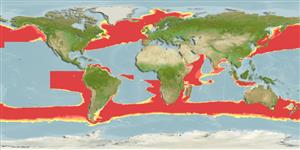>
Lophiiformes (Anglerfishes) >
Caulophrynidae (Fanfins)
Etymology: Caulophryne: Greek, 'kaulos' or 'caulis' = stem + Greek, 'phryne' = toad (according to Goode and Bean (1896): "a 'phryne'-like fish with the cephalic tentacle supported on a stemlike base") ( Ref. 86949); jordani: jordani named for David Starr Jordan, possibly America's ichthyologist (Ref. 4525).
Eponymy: Dr David Starr Jordan (1851–1931) was a leading American ichthyologist, physician, educator, peace activist and believer in eugenics; moreover, he was founding President of Stanford University. [...] (Ref. 128868), visit book page.
More on authors: Goode & Bean.
Environment: milieu / climate zone / depth range / distribution range
Ecologia
marino batipelagico; distribuzione batimetrica 100 - 1510 m (Ref. 5951). Deep-water
Circumglobal.
Size / Peso / Age
Maturity: Lm ? range ? - ? cm
Max length : 11.0 cm TL maschio/sesso non determinato; (Ref. 7300); 20.0 cm TL (female)
Short description
Chiavi di identificazione | Morfologia | Morfometria
Spine dorsali (totale) : 0; Raggi dorsali molli (totale) : 16; Spine anali: 0; Raggi anali molli: 17. Illicium pigmented except near esca, with 5-14 elongate translucent filaments along entire length, al but distal-most arising from posterior margin (Ref. 13608); length of illicium 16.8-36.8%SL; stem of illicium pigmented except near esca; esca with an elongate filamentous anterolateral appendage; 2 distal appendages, each bearing numerous filaments, anterior most short and stout, opaque along posterior margin, posterior most considerably more slender; posterolateral appendage bearing numerous short filaments and with palmate opaque distal tip; dorsal fin rays 16-19; anal fin rays 14-18; pectoral fin rays 16-19; upper jaw teeth 17-39; lower jaw teeth 12-26; teeth on vomer 2-5 (Ref. 86949).
Bathy- and mesopelagic (Ref. 75154). Males parasitic on the females (Ref. 559).
Life cycle and mating behavior
Maturità | Riproduzione | Deposizione | Uova | Fecundity | Larve
Paxton, J.R., D.F. Hoese, G.R. Allen and J.E. Hanley, 1989. Pisces. Petromyzontidae to Carangidae. Zoological Catalogue of Australia, Vol. 7. Australian Government Publishing Service, Canberra, 665 p. (Ref. 7300)
IUCN Red List Status (Ref. 130435: Version 2024-2)
Threat to humans
Harmless
Human uses
Pesca:
Strumenti
Special reports
Download XML
Fonti Internet
Estimates based on models
Preferred temperature (Ref.
123201): 1.1 - 13.7, mean 7.1 °C (based on 1411 cells).
Phylogenetic diversity index (Ref.
82804): PD
50 = 0.5938 [Uniqueness, from 0.5 = low to 2.0 = high].
Bayesian length-weight: a=0.01995 (0.00906 - 0.04395), b=3.01 (2.83 - 3.19), in cm total length, based on all LWR estimates for this body shape (Ref.
93245).
Trophic level (Ref.
69278): 4.0 ±0.7 se; based on size and trophs of closest relatives
Fishing Vulnerability (Ref.
59153): Low vulnerability (10 of 100).
